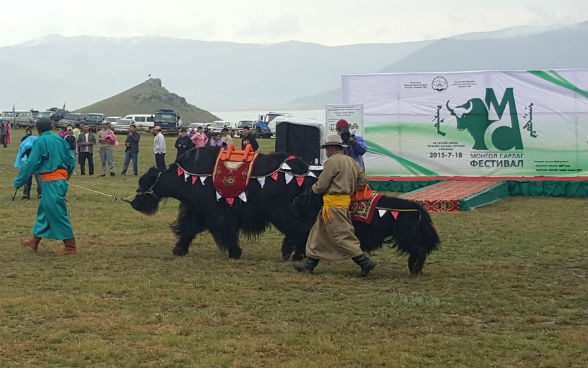
Arkhangai aimag is a home to 150,000 yaks, which represents 20 percent of its total livestock population. Herders annually supply more than 20 tonnes of premium-quality yak wool to domestic processing companies.
This year, the Arkhangai Aimag Federation of Pasture-User Groups of Herders - with support from the Arkhangai aimag government, the Tariat soum government and SDC’s Green Gold Project - organised the “Mongol Yak” Festival.
Boost local economy and development
The festival, attended by hundreds of local herders and 3000 visitors, was aimed at raising awareness among herder families about the importance of improving the quality of primary raw materials, wool, dairy products, hides/skins and meat, facilitating better collaboration between yak herders, cooperatives and domestic processing companies for sustainable value-chain development, and promoting local community-based tourism development.
“The yak festival is very important to develop Yak culture and tourism to bring as more people to the region” said Mr. G. Altan-Ochir, governor of Tariat soum of Arkhangai aimag.
Arkhangai herders are among those pioneers within the sector who have adopted new methods of combing through to the shearing of yak wool, which has significantly improved both the level of output and quality of the down delivered to processing companies.
Living in the Khangai mountain ranges of Mongolia, yaks are highly resilient and well adapted to the region’s harsh environmental conditions. Products made from yak down and hair are renowned for their ability to retain warmth. Yak down is as soft as goat cashmere, with the additional benefits of being both durable and comfortable to wear.
The unique colours of yak down - platinum, black and brown - make it an attractive material for modern clothing. Yaks also produce a number of other high-quality and valuable products. Yak milk cream is known for its taste and nutritional value, and yarn and households goods made of yak wool and hair are known for their high quality.
Highlights of Yak Festival
Competitions held at the “Mongol Yak” Festival among herders for educational purposes included “The Best Yak Bull”, “The Herder Family with the Best Yak Herd”, “The Herder Family that Prepared the Highest Amount of Combed Yak Down”, “The Herder Family that Prepared the Best-Quality Yak Dairy Products”, “The Best-Decorated Yak”, and “The Best Handcrafted Products Made of Yak Raw Materials”. Competition awards were sponsored by domestic processing companies: Bayalag Ulzii, Sor Cashmere, Uujin, Mongol Textile, Altai Cashmere, Jinst Murun and Tengri.
Processing companies also organised a “Fashion Show” of products made from yak down for herders featuring the latest fashions and designs.
During the festival, processing companies sold products worth MNT 7.2 million. Herder families who took part in the festival sold dairy products to visitors, earning MNT 10,1 million in income.
Two local tour operators working in the region also supported the festival, sponsoring cultural performances and arranging for tourists to visit the event.
The festival, which concluded with a midnight fireworks display, was indeed a celebration of local community, networking and collaboration to ensure a better future for the region.
SDC’s Green Gold Project aims to promote collective actions among herder households for the sustainable use of rangelands, economic development, and equitable and effective local governance. For more information, please visit www.greengold.mn

